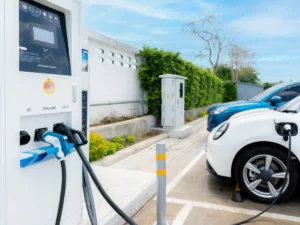
A financially sustainable commute uses different modes of transportation that can minimize expenses and maximize vehicle efficiency, which is affordable for every US citizen. It is also environmentally friendly, resulting in minimal CO2 emissions. Developing the habit of using vehicles that are financially sustainable is critical to reducing the negative impact on the environment.
Therefore, the use of financially sustainable commutes is beneficial not only for humans but also for our environment. Exploring the financially sustainable commute in the US can lead to the creation of new travel options such as walking, cycling, using electric or hybrid vehicles, carpooling and ride-sharing, among many other strategies.
Benefits of Financially Sustainable Commute
A financially sustainable commute provides various benefits, including saving our planet from greenhouse gas emissions, but it also enhances affordability for everyone and plays an important role in the contributions of a better transport system. Walking instead of driving alone reduces 30% of carbon emissions, improves air quality, and reduces traffic on the roads. Walking not only relieves traffic congestion but also serves as an effective form of exercise.
However, there are many alternatives by which you can travel. You can opt for public transport, which is not only cost-effective but also significantly reduces air pollution. By helping the environment, you can enjoy stress-free travel. Moreover, a sustainable commute offers numerous financial benefits, such as cost savings through the use of alternative modes of transportation, eliminating the need for vehicles that contribute to environmental pollution, and significant savings on car maintenance and gas costs.
According to the American Public Transport System Association, you can save $9,000 per year if you choose public transportation instead of driving alone. Check out this YouTube video where NSW Public Transportation System use 100% renewable electricity or watch below:
Ways to achieve financially sustainable commute

There are several methods to achieve a financially sustainable commute, such as raising awareness through the use of vehicles with low fossil fuel consumption and reduced carbon footprints, or educating people through seminars and awareness campaigns. The government should also play a role in promoting this practice at the national level, as it is not only a problem in America but also a global issue. Here are some ways to become accustomed to a financially sustainable commute.
Employer Incentives
Offering incentives to employers, such as providing a public transport system to them like transit programs, transit subsidies, or carpooling programs, or providing rewards for using bikes or walking to work, is a good way to create a financially sustainable commute, and in this way they can save a huge amount of money. Furthermore, implementing such eco-friendly steps is a great way to protect our planet.
Telecommuting
In this advanced technology era, we are all aware of telecommunications, which is a wonderful way to connect with people. We have the ability to create jobs globally, and this trend is growing and gaining popularity as a cost-effective alternative to daily travel. You can also contribute to environmental protection, work from anywhere in the world, and earn, learn, teach, and perform a variety of other tasks from the comfort of your home, without having to deal with traffic or use a car to get there. It’s the easiest way, and it’s now expanding globally.
Carpooling
Carpooling is another way to create a financially sustainable commute. There are various online apps such as Waze Carpool, Carpool Buddy, and Scoop that can assist in finding ride-sharers and provide directions for carpooling. Carpooling is the best choice to reduce fuel costs and tolls by sharing rides with co-workers, friends, or colleagues. Moreover, carpooling and ride-sharing enhance productivity, decrease travel times, and reduce traffic congestion.
Biking and walking
Bicycling and walking help to reduce CO2 emissions. Additionally, you don’t have to spend money while traveling. Bicycling burns approximately 510 calories of energy, promoting health, exercise, and cardio activity.
If you travel alone on a daily basis, you’re contributing to the escalation of problems instead of focusing on solutions. Therefore, it’s now up to you to decide whether to travel alone or opt for walking or biking, which contribute to zero emissions of greenhouse gases. Moreover, educational institutions, campuses, and universities should provide transportation facilities with innovative technologies.
Offering e-bikes to students makes commuting easier, and these electric alternatives are gaining popularity and beneficial for the environment as well. Starting programs like Earn a Bike for students is a good way to create a financially sustainable commute.
Micro Mobility Options
Maintenance of Micro Mobility Vehicles
For a short commute, using electric bikes, scooters, or skateboards can make a huge difference. E-bikes consume minimal energy or fossil fuels, allowing for stress-free travel. However, it’s important to take the necessary precautions for prolonged use of these scooters. Taking care of the tires, engines, and servicing them can provide long-term benefits. Additionally, better-quality scooters perform well, which is beneficial for their users.
Electric or hybrid vehicles have various benefits, like promoting environmental sustainability. These vehicles can lower fuel costs, reduce emissions, and provide financially sustainable alternatives to traditional gas-powered vehicles. But we should avoid keeping a hefty burden, which is unbearable; it can badly affect the vehicles, so it’s important to keep better maintenance of vehicles.
Benefits of Electric and Hybrid Vehicles
Alternative Commuting Services
Moreover, there are other ways to create a financially sustainable commute, such as car sharing and rental services that facilitate on-demand access. Moreover, it’s necessary to provide employer-sponsored programs or tax deductions for employees. A financially sustainable commute enables us to offer various benefits to employers, such as increased employee productivity, improved corporate social activity, enhanced recruitment and retention, and reduced parking needs.
Economic savings
By implementing a sustainable commute, Americans can reduce their fuel costs from $500 to $1,000 per year, their parking fees from $1,000 to $2,000 per year, their use of public transportation from $500 to $1,000 per year, and their vehicle maintenance costs, which can range from $1,000 to $2,000 per year due to increased physical activity.
Government incentives
The government should introduce eco-friendly initiatives and programs that support financially sustainable commutes. The government should enforce laws such as increasing taxes on car usage and parking, as this will directly lead to a decrease in the use of cars. A public transport system is a better choice because it reduces energy consumption.
The government can offer subsidies for public transportation, bikes for work programs, telecommuting incentives, etc. These are the facilities that the government can provide to locals to create a financially sustainable commute.
Importance of financially sustainable commute
Climate Change’s Growing Threat
With the growing population, air pollution is increasing day by day, causing climate change. As a result, heavy rains and storms destroy many places all over the world. This is because humans are not going to solve this problem; instead, we are polluting our own planet.
The solution: reducing emissions
Climate change exacerbates the economic situation, disrupts the education system, causes people to lose their homes, and forces them to migrate.
This is due to our lack of efforts to make our planet more environmentally friendly, which can only be achieved when we consistently adopt financially sustainable commutes. The solution to this problem is to reduce greenhouse gas emissions and use less fossil fuels or energy.
Advantages of Financially Sustainable Commute
Moreover, there are various advantages to creating a financially sustainable commute; it includes promoting health benefits, conservation of land, and the removal of harmful substances. We will regret adopting these strategies because they will make the future more critical.
Multidimensional Aspects of Sustainable Commuting

Financially sustainable commute encompasses economic, environmental, health-related, and social dimensions, which can make it more important in the future as well as in the present. Using public transportation not only reduces traffic congestion by reducing the number of cars on the road, thereby reducing emissions, but also expedites commutes.
Economic and Urban Development Benefits
A sustainable commute can improve economic conditions, which is beneficial in many ways for the government and citizens. A sustainable commute also encourages efficient urban development, making the environment healthier for us. However, while public transit may not be faster due to traffic jams, it significantly reduces the risk of accidents and is safer to use.
Strategies for Implementing Sustainable Commuting
Electric vehicles and ride-sharing
By developing and implementing policies, it becomes easier to create various job opportunities for citizens and provide them with transportation facilities that emphasize ecological responsibilities. We should cultivate a habit of sustainable commuting while we still have the opportunity. Electric vehicles are a better option, which makes transportation sustainable and reduces harmful emissions.
The cost of car ownership in America
Moreover, if you own a car, you should share a ride, as carpooling can save money and fuel costs for others. Many Americans own cars, which is an expensive and ongoing endeavor. They spend their money on buying cars, maintaining them, and operating them.
Transportation accessibility issues
Americans don’t spend more money on other alternatives, such as public transit. Meanwhile, gasoline prices will rise by 25% in 2023. Large numbers of Americans lack transportation.
According to the U.S. Environmental Protection Agency, transportation is the largest factor behind emissions of greenhouse gases. Therefore, American companies should also contribute to the creation of financially sustainable commutes.
Conclusion
A financially sustainable commute is the only way to contribute to a healthier environment and save millions of dollars. There are various ways to adopt this habit. Cycling makes people physically active, and biking reduces harmful emissions.
Also check out Las Vegas Renewable Energy: Pioneering Sustainable Progress
Citations
- https://www.us.jll.com/en/trends-and-insights/workplace/benefits-of-sustainable-commuting-habits
- https://energytheory.com/daily-commute-green-and-sustainable/
- https://www.weforum.org/agenda/2020/07/how-we-can-make-commuting-more-inclusive-and-sustainable-post-covid/
- https://environmentamerica.org/resources/sustainable-transportation/



Leave a Reply